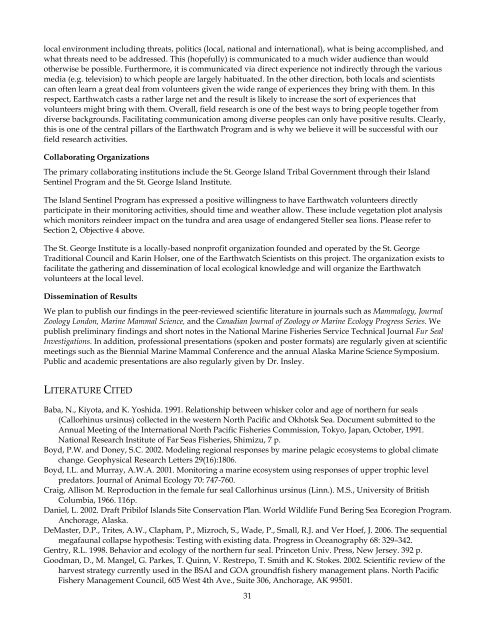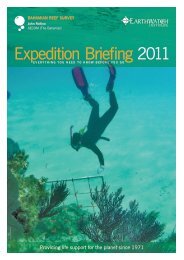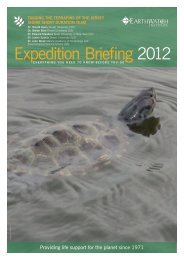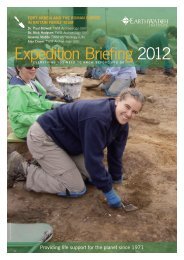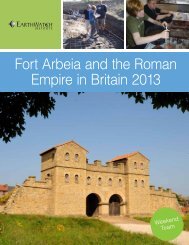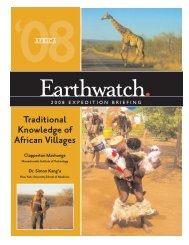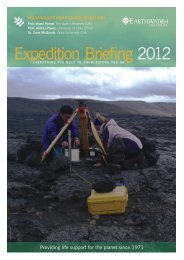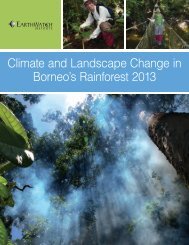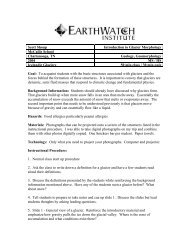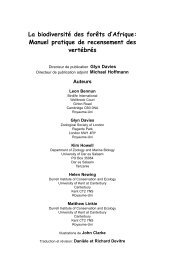Alaskan Fur Seals - Earthwatch Institute
Alaskan Fur Seals - Earthwatch Institute
Alaskan Fur Seals - Earthwatch Institute
Create successful ePaper yourself
Turn your PDF publications into a flip-book with our unique Google optimized e-Paper software.
local environment including threats, politics (local, national and international), what is being accomplished, and<br />
what threats need to be addressed. This (hopefully) is communicated to a much wider audience than would<br />
otherwise be possible. <strong>Fur</strong>thermore, it is communicated via direct experience not indirectly through the various<br />
media (e.g. television) to which people are largely habituated. In the other direction, both locals and scientists<br />
can often learn a great deal from volunteers given the wide range of experiences they bring with them. In this<br />
respect, <strong>Earthwatch</strong> casts a rather large net and the result is likely to increase the sort of experiences that<br />
volunteers might bring with them. Overall, field research is one of the best ways to bring people together from<br />
diverse backgrounds. Facilitating communication among diverse peoples can only have positive results. Clearly,<br />
this is one of the central pillars of the <strong>Earthwatch</strong> Program and is why we believe it will be successful with our<br />
field research activities.<br />
Collaborating Organizations<br />
The primary collaborating institutions include the St. George Island Tribal Government through their Island<br />
Sentinel Program and the St. George Island <strong>Institute</strong>.<br />
The Island Sentinel Program has expressed a positive willingness to have <strong>Earthwatch</strong> volunteers directly<br />
participate in their monitoring activities, should time and weather allow. These include vegetation plot analysis<br />
which monitors reindeer impact on the tundra and area usage of endangered Steller sea lions. Please refer to<br />
Section 2, Objective 4 above.<br />
The St. George <strong>Institute</strong> is a locally-based nonprofit organization founded and operated by the St. George<br />
Traditional Council and Karin Holser, one of the <strong>Earthwatch</strong> Scientists on this project. The organization exists to<br />
facilitate the gathering and dissemination of local ecological knowledge and will organize the <strong>Earthwatch</strong><br />
volunteers at the local level.<br />
Dissemination of Results<br />
We plan to publish our findings in the peer-reviewed scientific literature in journals such as Mammalogy, Journal<br />
Zoology London, Marine Mammal Science, and the Canadian Journal of Zoology or Marine Ecology Progress Series. We<br />
publish preliminary findings and short notes in the National Marine Fisheries Service Technical Journal <strong>Fur</strong> Seal<br />
Investigations. In addition, professional presentations (spoken and poster formats) are regularly given at scientific<br />
meetings such as the Biennial Marine Mammal Conference and the annual Alaska Marine Science Symposium.<br />
Public and academic presentations are also regularly given by Dr. Insley.<br />
LITERATURE CITED<br />
Baba, N., Kiyota, and K. Yoshida. 1991. Relationship between whisker color and age of northern fur seals<br />
(Callorhinus ursinus) collected in the western North Pacific and Okhotsk Sea. Document submitted to the<br />
Annual Meeting of the International North Pacific Fisheries Commission, Tokyo, Japan, October, 1991.<br />
National Research <strong>Institute</strong> of Far Seas Fisheries, Shimizu, 7 p.<br />
Boyd, P.W. and Doney, S.C. 2002. Modeling regional responses by marine pelagic ecosystems to global climate<br />
change. Geophysical Research Letters 29(16):1806.<br />
Boyd, I.L. and Murray, A.W.A. 2001. Monitoring a marine ecosystem using responses of upper trophic level<br />
predators. Journal of Animal Ecology 70: 747-760.<br />
Craig, Allison M. Reproduction in the female fur seal Callorhinus ursinus (Linn.). M.S., University of British<br />
Columbia, 1966. 116p.<br />
Daniel, L. 2002. Draft Pribilof Islands Site Conservation Plan. World Wildlife Fund Bering Sea Ecoregion Program.<br />
Anchorage, Alaska.<br />
DeMaster, D.P., Trites, A.W., Clapham, P., Mizroch, S., Wade, P., Small, R.J. and Ver Hoef, J. 2006. The sequential<br />
megafaunal collapse hypothesis: Testing with existing data. Progress in Oceanography 68: 329–342.<br />
Gentry, R.L. 1998. Behavior and ecology of the northern fur seal. Princeton Univ. Press, New Jersey. 392 p.<br />
Goodman, D., M. Mangel, G. Parkes, T. Quinn, V. Restrepo, T. Smith and K. Stokes. 2002. Scientific review of the<br />
harvest strategy currently used in the BSAI and GOA groundfish fishery management plans. North Pacific<br />
Fishery Management Council, 605 West 4th Ave., Suite 306, Anchorage, AK 99501.<br />
31


